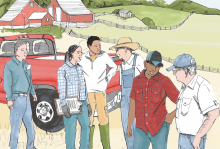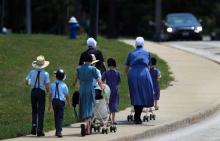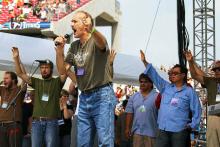midwest

IT WAS COLD — even for northwest Iowa in November. And I was late.
I thought I could make up time if I took the back way, a route I’d driven many times before. But the one-lane bridge across the Rock River was out and, judging by the abandoned construction site, it hadn’t been open for a while. I had moved away four years earlier and was a little behind on local traffic patterns.
To locals, the region surrounding the Big Sioux River drainage basin—stretching across parts of Iowa, Nebraska, South Dakota, and Minnesota—is known as “Siouxland.” To most Americans, this is flyover country.
I grew up in Siouxland, crisscrossing the region for family gatherings, 4-H horse shows, and trail rides, but I knew my time there was limited. Through TV, I learned about life in the big city and what the rest of the country thought of hicks, hillbillies, and hayseeds like me. I learned that to be successful, I had to leave. And so, like many of my classmates, I left as soon as I could.
I went to college in Minneapolis and pursued a career in media; after graduation I spent time in Los Angeles, New York, and Washington, D.C., working on shows such as Monday Night Football and Good Morning America.
But on the morning of May 12, 2008, everything changed: Hundreds of federal agents from Immigration and Customs Enforcement raided an Iowa meatpacking plant, arresting 389 community members. At the time, I was a media producer for Sojourners, so I traveled to Iowa to cover the humanitarian response organized by Sister Mary McCauley, parish administrator of the local Catholic church.
Within hours of the raid, Sister McCauley had the entire community of 2,269 residents organized. When I interviewed her a few days later, the church was full of children still waiting to be reunited with their families. The church’s fellowship hall was filled with clothes, meals, and supplies for the children; community volunteers worked through legal paperwork on behalf of those detained. In a moment of complete chaos, community members rose to the challenge and stood together with their neighbors. It was at this point I realized the power of rural organizing. I was hooked.
Leveraging the gifts of the community
IN MARCH, AS the pandemic caused by the novel coronavirus erupted around the world, rural hospitals in the U.S. faced a particularly grim reality: Like hospitals across the nation, they faced a shortage of personal protective equipment such as N-95 masks and gowns. But unlike their urban and suburban counterparts, rural hospitals were already struggling. According to a 2017 study, 41 percent of rural hospitals operate at a loss, a result of decreasing Medicare reimbursements, more patients with underlying conditions, and fewer patients with private insurance. “We’re stretched thin as it is,” one hospital CEO told the Washington Post. “We’ll improvise and make it work however we can.”
As cases of COVID-19 skyrocketed, I thought about McCauley and all the organizers like her that I’ve met in the 12 years since the Postville immigration raid. Many of the best community organizers I know would never give themselves that title. They don’t work for a campaign or an organization. Often, they’re just everyday folks who believe their community is worth fighting for.
RURAL COMMUNITIES in the U.S. wrestle with many of the same problems facing the rest of the country—persistent unemployment, access to quality health care, air and water degradation, a broken immigration policy. Other issues—such as supporting sustainable farming practices and drawing young people into agriculture, lack of broadband access, and the challenges of small-town economic development—are more unique to rural life.
Even though the 46.2 million people living in rural U.S. counties constitute only 15 percent of the country’s total population (spread across 72 percent of the nation’s land area), we are all connected—urban, suburban, and rural—by foodways, waterways, wilderness areas, and our national politics. As one Midwest-based organizer put it, “many progressives fundamentally don’t understand rural America—they don’t even know why they should care about it. You can’t understand the power of the tea party without understanding rural America. It is the key to the House of Representatives, and progressives will be hamstrung until they can make inroads in a few key congressional districts.”
But that organizer and others also draw power and hope from the deep history of populism in the rural Midwest and parts of the South, and the endurance of community-oriented values that aren’t just “heartland” clichés.
While many young people are itching to leave rural areas and small towns—anxious to find better jobs, educational opportunities, or city culture—others have always stayed put or returned after time away. And some “city cousins” move to rural America, enjoying the opportunity to work on issues they care about (with the bonus of a brilliant night sky). Here are four stories of young people investing in rural communities in the Midwest. —The Editors
“It makes a difference in the lives of people.”
Rae O’Leary, 29, is a respiratory therapist and nurse on the Cheyenne River Indian Reservation in north-central South Dakota. The reservation straddles two counties, the fourth- and 11th-poorest in the nation. O’Leary works for Missouri Breaks Industries Research Inc. in Eagle Butte, the reservation’s hub with a population of about 1,300. She lives 20 miles out, on a ranch with her husband and two young children. O’Leary is a member of the Turtle Mountain band of Chippewa; her husband is a member of the Cheyenne River Sioux Tribe, and their children are enrolled in that tribe.
“When I define how rural we are, I tell people our nearest Wal-Mart is two hours away. That’s my point of reference for city folk.

The Amish are one of the fastest-growing religious groups in North America, according to a new census by researchers at Ohio State University.
The study, released July 27 at the annual meeting of the Rural Sociological Society, suggests a new community sprouting every three and a half weeks.
Nearly 250,000 Amish live in the U.S. and Canada, and the population is expected to exceed 1 million around 2050.
The growth may not be visible outside Amish country, but the rural settlements definitely see the boom.

PEORIA, Ill. — When Max and Nancy Carson got married at St. Ann Catholic Church in 1974, the organ music was accompanied by the unmistakable sound of balls crashing into bowling pins.
"I said 'I do' and bowling balls were flying," said Max Carson, 62, who didn't know then that the St. Boniface Bowling Alley, built in 1945, was housed in the church basement. Now he plays in the Has-Beens League every Wednesday morning in the four-lane alley.
"I always joke that if I preach too long, people go downstairs and start bowling," said St. Ann's pastor, the Rev. Terry Cassidy.
St. Ann's little bowling alley is almost as popular now as it was after parishioners created the hideaway, which has a bar and dining room. It was rebuilt after a fire in the 1960s. Two leagues, one for men and another for women, play on Wednesdays, and parties are booked for almost every Friday and Saturday night, manager Jim Seppelt said.
Church bowling alleys are disappearing fast. There are probably fewer than 200 left, said Neil Stremmel, of the U.S. Bowling Congress.

Though I treasure my Pentecostal heritage, these days I feel like an outsider looking in, because though it started out as a pacifist movement in the early 20th century, today Pentecostalism (at least in America) is largely known as a religion that spawns extremist movements that trumpet militarism and bigotry.
Chief exhibit: The Call
Founded by Lou Engle, The Call is a movement that regularly holds massive prayer events in stadiums across the country. Engle is part of a network called the New Apostolic Reformation, which believes that God is raising up an end-times army of apostles and prophets to take over earthly governments before Jesus comes back.
A few of its prominent leaders are Peter Wagner, Cindy Jacobs, Rick Joyner, and Mike Bickle. Though the end-times theology of these individuals may vary, the underlying principle that binds them together is the idea that Christians are called to dominate earthly governments and civil society, and that apostles and prophets are supposed to pave the way to make that happen.